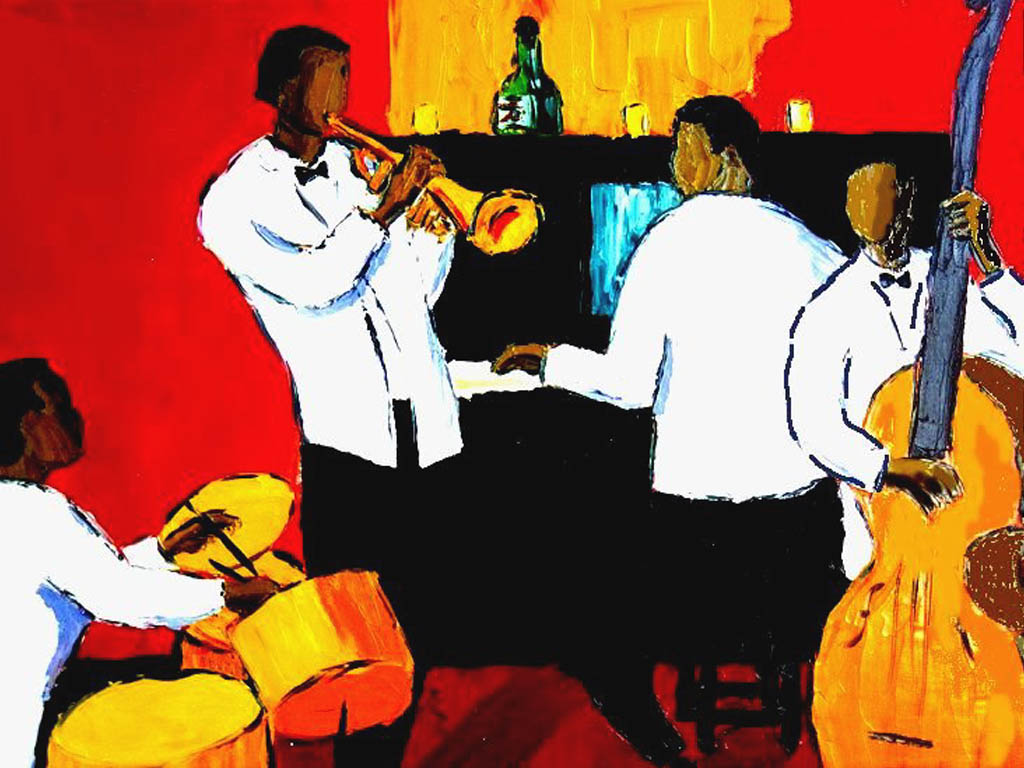
The Jazz Annex
A Resource for Guests of
Tony Flood's House of Hard Bop
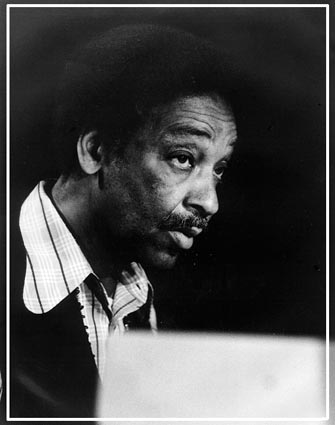
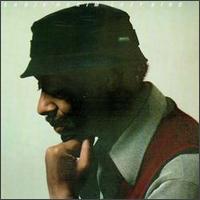
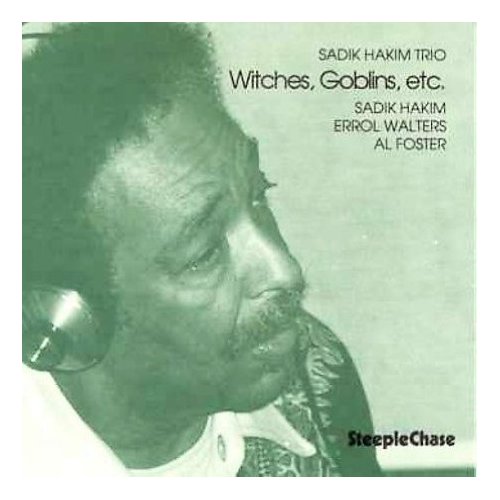
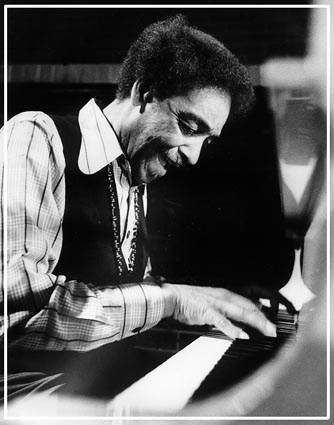
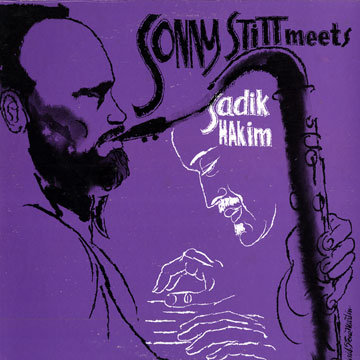
Reflections of an Era: My Experiences with Bird and Prez
Sadik Hakim
From Jazz Journal International [London], Vol. 49, No. 8, August 1996, pp. 16-18, 35.
JJI's editor prefaced Hakim's memoir with an account of its origin. I have made only slight stylistic corrections.
– Tony Flood
July 21, 2010
Some readers may be familiar with a small publication called Jazz in London which lists jazz gigs and events within the London area. This is compiled and published by Mary Greig. Visiting New York in 1981 she met Sadik Hakim then in relative obscurity, and struck up a friendship. During correspondence after her return to London, Hakim sent her this manuscript, partly for the satisfaction of relating his experiences, she believes, and perhaps partly for publicity purposes. Early in 1995 Mary was sorting out some old papers and came across this manuscript, untouched, and so far as she knew, unseen, by anyone else. Hakim died in 1983. Mary thought this might make an interesting feature article and we agreed.
In order not to infringe any copyright that might exist we instituted enquiries to see if the article had been published earlier. We discovered that it had indeed appeared before, in an obscure publication called Jazz Spotlite News which published ten issues only between June 1979 and summer 1982. All attempts to trace copies of this periodical or anyone associated with it—or who even remembered it!—via our several contacts in New York, have proved fruitless, but we freely acknowledge their original publication which may or may not be precisely as this story appears.
Pianist Sadik Hakim was born Argonne Thornton on July 15, 1919. His maternal grandfather was a violinist, composer, conductor and professor of his own school of music. His grandmother was a cellist, his mother a violinist, his aunt a pianist and violinist and they performed together as a chamber music group. This is Sadik’s own story as told in writing to Mary Greig.
* * *
I was born in Duluth, Minnesota in 1919; my family was musical. My grandfather is still the only black man to have conducted his own compositions with the Duluth Symphony Orchestra. But I didn’t get serious about playing until I went to Los Angeles, after my high school graduation (1937) to visit my father. There I met Dexter Gordon, Illinois Jacquet and other fine young players. When I went back to the Mid-West to go to the University of Minnesota (only one year), I also played with Oscar Pettiford’s family band. The whole family, his father, even his sisters, played on several instruments.
In 1938 I went to Peoria to play with Fats Dudley, a 300-pound trumpet player and singer who played and sang like Louis Armstrong. Morris Lane the noted tenor player was also there at that time. He had to leave town not long after I came because of his involvement with a white girl. In 1940 I myself was run out of Kankakee, Illinois, for the same reason—the daughter of the President of Kresge’s Department Store. These were very prejudiced times and places.
Fortunately Chicago was only 50 miles away. I remember playing with many great musicians there, including the young Wilbur Ware and a tenor player named Buster Brown who accompanied himself on sock cymbal with his foot. I went to work with Jesse Miller, a trumpeter who had been with Earl Hines. A. K. Atkinson the arranger who later became A. K. Salim and who introduced me to Islam, was on alto; Goon Gardner was the other alto. The drummer was Ike Day, a kid, only 15. Ike Day was playing two bass drums then; out of sight; a big influence on Max Roach and others. (He died of an O.D. in New York a few years later).
This group was playing at a club on 63rd and Cottage Grove called Joe Hughes’s Deluxe. The featured acts were female impersonators backed by (real) chorus girls. One night we were playing Stompin’ At The Savoy for the chorus girls when, out of the blue we heard this horn from the front of the club playing over the top of the band. I looked up and saw Charlie Parker. He never stopped playing, just walked right through the chorus girls and came and stood over by the piano. Jesse Miller, who had played with Bird when Bird played second tenor for Earl Hines, had told me that Bird’s ability drove Hines’ first tenor (Bob Crump) to quit playing. A. K. and Goon had also been telling me about Charlie Parker. At that time, of course, Benny Carter and Johnny Hodges were my main men on alto. After hearing Bird that night I forgot about all other alto players.
I started hanging out with Bird in Chicago. (This was years before I recorded with him in New York.) Bird got a gig at the Rum-Boogie, a club on 55th Street and Central Parkway (now Martin Luther King Drive). As my gig with Jesse Miller started later than Bird’s, I would go with him to hear his first set. The band, about ten pieces, was led by an old man who played violin. Marl Young, the pianist, wrote the music for this band—very, very hard but good music. (Marl Young lives in L.A. now and writes for the movies.) Eddie Johnson, a great tenor player, was in the band; Gale Brockman and Billy Orr were on trumpets.
Anyway, Bird was never there for rehearsals. The band would rehearse all afternoon, Bird was never there, and the other members of the band were mad and didn’t like Bird. But the leader, the old man, did like Bird, which is why he never got fired. I remember this incident like it was yesterday. I went by with Bird to hear his first set. He always came about two or three minutes before the show hit. He’d look at the third alto part, glance at his part (he was playing lead); when the curtain came up, Bird was playing that music like he owned it plus adding things to the part. Well this night, Jimmy Dorsey was playing at the Sherman Hotel in the Loop, and he came down to hear Bird. The old man, Bird’s bandleader, knew what was happening. He called Cherokee, which featured Bird. Bird, of course, played like a man possessed. Jimmy Dorsey came back to the dressing room, introduced himself, and said to Bird, “Here man, you need this much more than I do,” and gave Bird his brand-new padless Selmer. I was with Bird the next day when he put it in pawn. I begged him not to. His own horn was a wreck, held together with tape, gummed paper, etc. This didn’t matter to him.
At that time there was a great club on the South Side, the Club De Lisa. The leader of their 12-piece band was a great show drummer, Red Saunders. Chicago was wide open then. You could buy liquor in drug-stores, and clubs were open 24 hours. On Saturday night and Sunday morning, every-one would go to the De Lisa—all the biggest sportsmen (pimps), the top whores, top Mafia hoods who would make the all-time Mafia list, if I could remember names. (I guess it’s better that I can’t). Well, I’d get off my gig at around 4:30 and, with Bird and other cats, go to the De Lisa. Bird would sit in with Red Saunders’ band, which included altoist Nat Jones, a great player in the tradition of Johnny Hodges. Also playing was a great tenor player from Texas, Tom Archia. Billy Eckstine was on the show; this was before he formed his first band. Also the tap dancer Baby Lawrence, who I heard trade fours with Bird on a Limehouse Blues, way up-tempo. This was taken down on a wire recorder, a classic. I don’t know who has this wire recording, which must be worth many thousands of dollars by now. Incidentally, the greatest comedian George Kirby was a bus boy in the De Lisa and got his start there by filling in with comedy.
I remember hearing Art Tatum with Bird in Chicago. After his gig in the Loop, Tatum would come down to a club on the South Side, drinking beer after beer and playing for five or six hours. All piano players in the city would be there. I remember Bird telling me then, “I wish I could play like Tatum’s right hand.”
I did work a gig with Bird in Chicago. For a while we played at the Sherman Hotel with Hot Lips Page opposite Boyd Raeburn’s Big Band. The second day of the gig, we couldn’t find Bird at all for the second set. We went up to our suite in the hotel, where we found Bird out cold in the bathtub. We got him together, he came down, and his playing just scared everyone to death. Charlie Ventura was with Raeburn’s band. The more Bird played, the paler he got.
When Bird left Chicago I rejoined Jesse Miller at the Downbeat Club. Red Allen was also playing there, with J. C. Higgenbotham on trombone. Ben Webster came in from New York to play as a guest artist with Red Allen. But he liked our rhythm section better. We’d play on the one the radio one hour, six nights a week. (It was so very hip then). Well, when Ben left to go back to New York, he told our rhythm section (Rail Wilson, bass; Hillard Brown, drums) he would send for us to come and play with him on the Onyx Club on 52nd Street. We thought he was kidding, but in about a month he sent us first-class sleeping train tickets.
This was in 1944. I was with Ben for 15 months on 52nd Street. Brown and Wilson went back to Chicago when the brownouts came in 1945. New York was it for me. The rhythm section at the Onyx Club became Eddie Nicholson (drums), Gene Ramey (bass) and myself. Many times Roy Eldridge would play with us, or Stuff Smith, or Bob Dorsey, a great tenor player. Then it was Bird—always late. Mike Weston, the Onyx Club owner, would be frowning as Bird came in late, but after a couple of Bird’s choruses, he’d be smiling. One night Bird was very, very late. Bird came in while Ben Webster was drinking at the bar; the rest of us were trioing. Bird picked up Ben’s tenor and said I Cherokee. He played that tenor like he owned it, and Ben was shook. He just kept saying “Give me another double.” The thing about this was that nobody could get a sound out of Ben’s tenor but Ben himself, due to the thickness of the reed, etc. I saw many great tenor players try-Prez, Buddy Tate, Ike Quebec, no good!
During this time I played the Ko-Ko date with Bird as I was living with him at 117th Street and Man-hattan Avenue, in Harlem. I was sent to the land-lady, Doris Schneider, because we were both from Chicago. I introduced Bird to Doris, and a week later he was living there. Later, for a while, they were married. Billie Holiday and her man, trumpeter Joe Guy, also lived in this eight room pad. Bird drew people like Thelonious Monk, Miles, and Dexter Gordon to the scene. Why this place didn’t get busted, I’ll never know. Everything was happening there.
About the record date; Bud Powell was supposed to be the pianist, but he was hung up in Pennsylvania and didn’t get back. Incidentally, the first pianist I heard playing like Bird was not Bud, but Elmo Hope. But Bud played so strong, he just took that style over. Bud was not easy to get along with, kind of a ferocious guy. He’d throw shoes at his little brother, Richie, when Richie tried to listen to us playing. He’d say things like, “Get up off that piano stool, you blind mother----!” to people like [Art] Tatum and [George] Shearing. He and Bird, despite their mutual love and respect, did not get along; their personalities clashed. But I hung out a lot with Bud. I think he liked me because I didn’t try to copy him. Naturally, I learned his tunes, but I didn’t slavishly imitate his solos.
With Bud, as I said, in Pennsylvania, Bird brought me to the record date, and I played on all the tunes except Now’s The Time and Billie’s Bounce. That was Dizzy (who happened to be recording with another group in the same building). For many years I didn’t get credit for this date on the liner notes, which have now been straightened out. Nor did I ever get paid for it. This is because I was still on transfer from the union in Chicago. The union delegate at the studio said that I couldn’t play, but as soon as he left, Bird told me to come out and play. My first paying record date was with Dexter Gordon. At this time (1945) I also recorded with Ben Webster, Big Sid Catlett, Eddie Lockjaw Davis and Bill DeArango.
My association with Bird and Bud helped to bring the new music on to 52nd Street. Bud would sit in at the Onyx Club while I worked there. Most of the musicians there didn’t understand Bud or Bird. Roy Eldridge would take me outside to smoke (everyone smoked then, we called it “gage”) and ask me about what Bird and Bud Powell were doing. I couldn’t tell him, all I knew was that it sounded great, made musical sense, and swung like no other music I’d heard. It made all the other music sound stiff and unswinging. This is what I’d tell Roy. The one exception was Prez, Lester Young.
I had always dug Prez. He used to come to Minneapolis with Count Basie before I left that area. I first heard Prez with his own group at the Spotlite Club on 52nd Street. He had just come from L.A. after his stint in D.B. (the army’s disciplinary barracks, thus the tune D.B. Blues). He had Kenny Kersey on piano. When Prez decided to revamp, I got the gig. Shadow Wilson was on drums (Lyndell Marshall on the road), Prez’s friend Rodney Richardson on bass, Bennie Harris on trumpet. Bernie brought Bud Powell to Prez as we were boarding the plane for our first road gig, but Prez said, “I’ve already got Lady Dense.”
That was me. My name at the time was Argonne Dense Thornton, and Prez called everybody “Lady” (most famously, Lady Day [Billie Holiday]). He had, incidentally, his own lingo for everything, and it took me several months to understand him. But it was all appropriate. The police he called “Bob Crosbys.” If something was a real drag, he called it a “von Hangman.” His most famous expression, “I feel a draft,” could mean that he detected racial discrimi-nation or that he felt bad since you wouldn’t drink and smoke with him. Reefer he called “Ettuce.” Whites he called “grey boys.” (I don’t know if he originated that term.) Blacks were “Oxford greys.” The bridge of a tune he’d call a “George Washington.” When we hit a new town and Prez would go looking for an old girlfriend, he’d say he was going to see “a Wayback.”
This gives me a chance to correct two en-tirely false rumors about Prez. One, he was not a faggot, not at all. Two, he was not into heroin or cocaine: he just smoked and drank. He was a great human being as well as one of the greatest jazz soloists of all time: responsible about money, generous with his possessions, natural, friendly, gentle, as well as creative.
With Prez I recorded the famous hit Jumpin’ With Symphony Sid, which in fact is my composition. The studio man came in and asked us, as we were warming up, to do something with Symphony Sid’s name in it, as we were going back to the Three Deuces on 52nd Street and the disc jockey had his radio show from there. Meanwhile, I was playing this blues melody off the top of my head. Prez said, “We’ll play that,” and we did it in one take. The A&R man just assumed that the tune was Prez’s.
While I was with Prez, the drummer, Lyndell Mar-shall, had a nervous breakdown. At my suggestion, the great Roy Haynes came into the band.
I remember a couple of things about Bird that happened while I was with Prez. Prez and I were in [Washington] D.C. at a club called Caverns, and Bird was also in town with Duke Jordan on piano. Bird asked me to join the band (not, I’m sure, because he didn’t like Duke’s playing, but for personal reasons, which my reply explains). I told Bird, “I love you, but I can’t put up with your not paying people and leaving them stranded in different places. If you did that to me I’d have to hurt you or try to, and I’d hate to have that happen because I love you. I’d rather be your friend and listen.”
Another time when I was with Prez, we had a week off before a gig in Chicago, so I went to Chicago ahead of time to hear Bird and Miles. The saxophonist who had the house band at the club where Bird played was named Eddie Wiggins. Wiggins had a long line of reed instruments up on his bandstand—clarinet, flute, bassoon, alto, tenor, English horn. Bird came in, early for once—no one else in his band was there. He had left his horn at the club. Now Bird had very good connections in Chicago, but this time he had apparently forgot to pay them. He opened his horn case to find all the keys torn off or broken. Without blink-ing an eye, Bird asked Wiggins if he could play the first set with Wiggins’ group. Then he proceeded to play all those instruments, a few choruses on each one, even the bas-soon. Of course, I was dumbfounded; Bird never ceased to amaze me. I remember him astounding some Afrikaaner mathematicians by suddenly solving a problem they were discussing; they couldn’t believe that Bird didn’t have an advanced degree in math. Same thing with chess. Tadd Dameron and Max Roach would be playing up at Dizzy’s, Bird and I would come in, Bird would walk over to the board, make a move and say “Checkmate.” And Bird is the only person who knew me before I became a Muslim and changed my name who never, after I told him my new name, called me anything but Sadik Hakim.
One thing Bird and Prez had in common; I remember both of them cutting Benny Goodman and embarrassing him. When I was with Ben Webster at the Onyx Club and Bird was across the street at the Spotlite Club, I’d go over to hear Bird as soon as our set ended. One night Benny sat at a front table as Bird began his set with Dizzy Atmosphere—way up-tempo. When he looked over and saw Benny, he changed to Dizzy Fingers (a feature of Benny’s). In the first eight bars, Benny turned red, green and all kinds of colors.
Later, with Prez on tour in L.A., we played opposite Benny at the L.A. Auditorium. (Frankie Laine was the between-sets act). Funny thing, Prez played his silver metal clarinet all night, never touching the tenor. He blew Benny away. All of us broke up as Benny turned red and a few more colors once again.
(The story is that Benny gave Prez this old metal clarinet, so maybe there was another reason for Prez to play it that night-Ed.)
I used to play Sunday afternoon gigs with Bird in Philly. The house band at this club had John Coltrane playing alto. At that time the very young Trane was probably the second best altoist in the world. I also played with Sonny Rollins back in the 40s. We both worked in a group led by trumpeter Louis Metcalfe, an older man who had played with Ellington. I used to marvel at how Rollins could get such great solos out of the corny tunes we had to play. He was playing tenor then, but I had known him even earlier, when he was playing alto. (In 1961, I closed Birdland with Sonny) [Birdland closed in 1964.—T.F.]. I also remember some great, unknown saxophonists whose careers were tragically cut short. Like Henry Pryor, an alto player in the style of Bird, who got killed by police in Chicago while breaking into a church to get money for dope. A great waste. Or Lank Keyes a tenor player influenced by Prez, also very great, who O.D.’d in Chicago.
There have been and still are, many great saxo-phonists—Coleman Hawkins, Benny Carter, Johnny Hodges, Sonny Stitt, and today, George Coleman, Junior Cook, Clifford Jordan, Johnny Griffin. Still, no one has had a story to say like Bird and Prez. When I was working at the Onyx with Ben Webster, and Prez was across the street at the Spotlite Club, Dexter Gordon would march up and down in front of the Spotlite with a huge sign saying, GO IN AND HEAR THE TRUTH. Maybe THE TRUTH is what we should have called it. (Bird hated the name Be-Bop, which was Dizzy’s concoction.)
I will take this opportunity to get one other thing straightened out. The tune Eronel, attributed to Monk, is another composition for which I should have gotten credit. When I was at the Onyx Club with Webster, I met a beautiful 17-old lady from Kansas City named Lenore. We were together about a year. The tune I wrote for her was her name spelled backwards. Monk came over to my house one day, saw the music on the piano, played it and liked it, even suggested a chord change (which I rejected). I went to Montreal for a year in 1949, and when I returned, I heard the same exact tune, credited to Monk, on a record he made with Milt Jackson. Monk told me that he just forgot to tell the record company the tune was mine. Incidentally, anyone should be able to tell that Eronel does not sound like a Monk composition.
Monk is, of course, a great genius, and continued on he showed me many of his tunes. Earl Hines and Nat Cole were among the first pianists I really dug. Then Elmo Hope and Bud Powell. My favorites in the last two decades: Hank Jones and Tommy Flanagan—they’re even in my book. In the new breed I like Cedar Walton, Mickey Tucker, John Hicks, for sure Kenny Barron, and Herbie Hancock—when he was playing piano. Electronic music is garbage to me. Everything is too loud to swing and, as Duke said 50 years ago, It Don’t Mean A Thing If It Ain’t Got That Swing. Among women pianist, I like Boo Pleasant, Shirley Scott, Terry Pollard. Among the less well-known, Willie Anderson, from Detroit, without peer, and Charles Fox from St. Louis (whatever happened to him?). But don’t let me forget Barry Harris, Walter Davis, Walter Bishop, Bill Evans, Horace Silver, Oscar Denard, McCoy Tyner, Chick Corea, Oscar Peter-son—so many great players, I can’t name them all.
Although I once watched Prez and Coleman Hawkins drink next to each other at a bar (the Spotlite Club, owned by the late Clarke Monroe) for two weeks without speaking, it seems like the musicians were closer in those days. Playing with Prez for those two or three years was one of the best times in my career. And I’ve had many good ones.
In 1961 Hakim made his first record as a leader (in conjunction with Duke Jordan). He played around New York with his own trio, then returned to Canada from 1966-76 and made records for CBS. He left Canada to tour Europe for a year, making a trip back to his native Duluth to play in the Bi-Centennial festival in 1976.
Returning to New York he made several recordings on the Progressive, Steeplechase, and CBS labels. Only the latter two were available in the United States, but all were available in Japan where he toured in 1979-80 and hoped to return. While there he also played an extended engagement at the Lofe 6 club in Osaka.
Partial Discography:
· Witches, Goblins, Etc. (Steeplechase)
· I Remember BeBop (CBS)
· Jazz Pianos of Duke Jordan and Sadik Hakim (Parker)
· Resurgence (Progressive)
· Piano Conceptions (Progressive)
· Memories (solo piano) (Progressive)
· A Bit of Monk (Progressive)
· Deep Roots (with Sonny Stitt) (Progressive)
· with Charlie Parker (Milestone)
· with Lester Young (Blue Note)
· with James Moody (Prestige)
· with Dexter Gordon (Prestige)
· with Buddy Tate (Prestige)